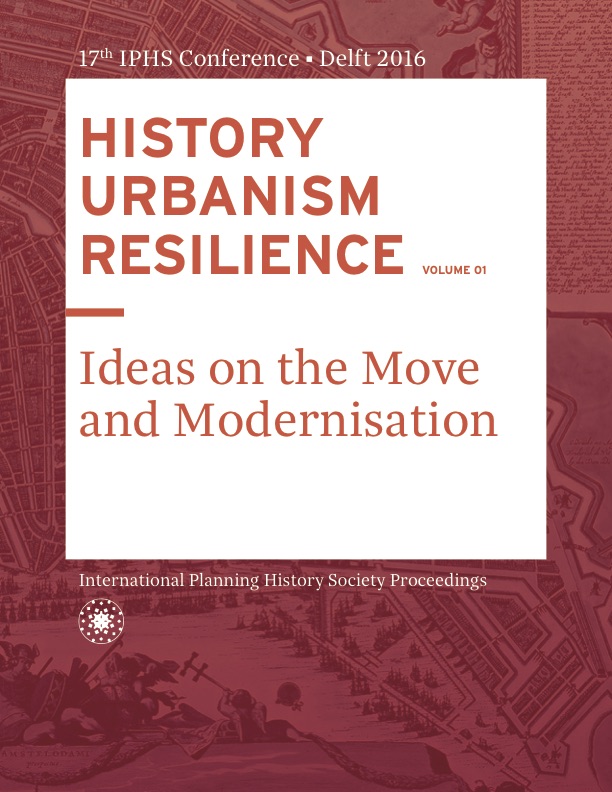Determining factors for the urban form and its orientation in Spanish colonial town planning : Planning the town of Guatemala in the 18th century
DOI:
https://doi.org/10.7480/iphs.2016.1.1218Abstract
The planning methodologies of the Spanish colonial such as urban form, planning of streets, blocks, and squares, and scale planning are basic principles of sort of a “new town” planning in the early modern period. Some of those concepts and actual town construction cases already provide planning philosophy as a foundation of the Modern city planning. This paper especially focuses on the determinants of the size and urban form, which are defined rather in the Modern city planning. From the 19th century on, town’s scale is calculated commensurate with the population size. In the Spanish colonial town planning, basic planning philosophy regarding the size and urban form of a city is illustrated but in the actual town construction, it was hardly realised in theory. This paper aims to clarify the determining factors of a urban form in the Spanish early modern period through the case study such as the town plan of Guatemala in the 18th century.First, this paper gives consideration to the planning philosophy illustrated in the representative planning norms such as the Ordinances of Philip II (1573) and the Laws of the Indies in 1680. Neither of them includes provisions on the town wall or an outline, and no interest on the town’s boundary or scale is shown.
Secondly, this paper studies the planning philosophy concerning town shape and the orientation of streets in the Renaissance architectural theory that greatly influenced the planning philosophy of Spanish colonial towns. Those Renaissance Vitruvian ideas show determining factors for town shape and the direction of streets in relation with the local main wind direction. However, the Vitruvian ideas have validity in the explanation for town layout only if illustrated with a shape of perfect polygon or geometrical shape. Historically the planning of this type has been hardly realised and the determining factors for the urban form have been obscure in the early modern period.
Thirdly, this paper studies the determining factors of town’s scale and shape from the practical town plans. Comparing several town plans such as those illustrated in case of the reconstruction of Guatemala City in the 18th century, the key determining factors for the town shape are discussed here.
Consequently the following planning techniques were observed. (1) Although the town shape is generally based on the geographical conditions, use of the straight lines is remarkable for the determination of town’s outline. (2) The bending points of town’s outline are determined not by the geographical conditions but largely by the eight directions of the land illustrated using the very central point of the town. (3) These techniques provide a planning method in which it is quite ease to identify the local eight orientation of the compass for the inhabitants, if connecting the locations such as vertex to town centre or vertex to vertex, utilising the polygonal outline. These show that the geometry took precedence over geographical conditions in drawing a town plan.
References
Solano, F. et al., Historia urbana de iberoamericana, Tomo I, La ciudad iberoamericana hasta 1573, Consejo Superior de los Colegios de Arquitectos de España, Madrid: Testimonio, 1987.
Hardoy, Jorge E. y Aranovich, Carmen. “Escalas y funciones urbanas de la América Española hacia 1600. Un ensayo metodológico,” ‘Estudios sobre la ciudad iberoamericana’, Madrid: C.S.I.C., 1983, pp.346-347.
Solano, Francisco de, Cedurario de Tierras. Compilación de legislación agraria colonial (1497-1820), Universidad Nacional Autónoma de México, 1991.
Recopilación de leyes de los reynos de las Indias. 3 tomos. Madrid: Centro de Estudios Políticos y Constitutionales y el Boletín Oficial del Estado, 1998.
Oakah L. Jones, Guatemala in the Spanish Colonial Period, University of Oklahoma Press, 1994.
Camara, Alicia, Fortificación y ciudad en los reinos de Felipe II, Madrid: Nerea, 1998.
Kashima, Akihiro, “Preliminary essay on the continuity of town planning concepts of the renaissance “ideal city” and the modern town planning -focusing on the text descriptions by vitruvius and alberti, and the image description by scamozzi”, 15th IPHS Conference Proceedings, São Paulo, Brazil, 2012.

